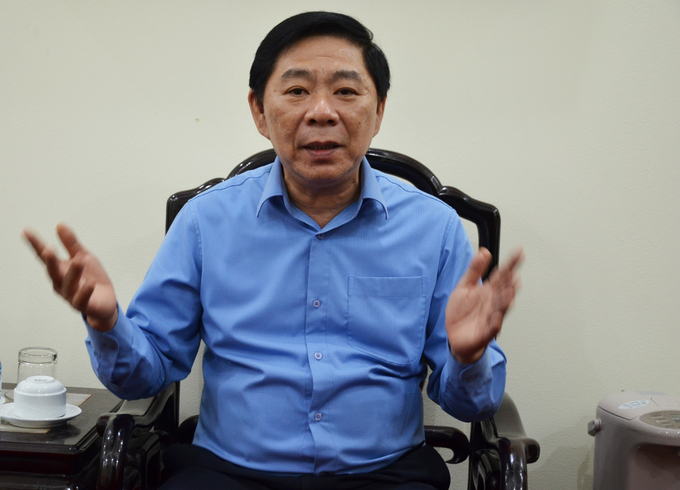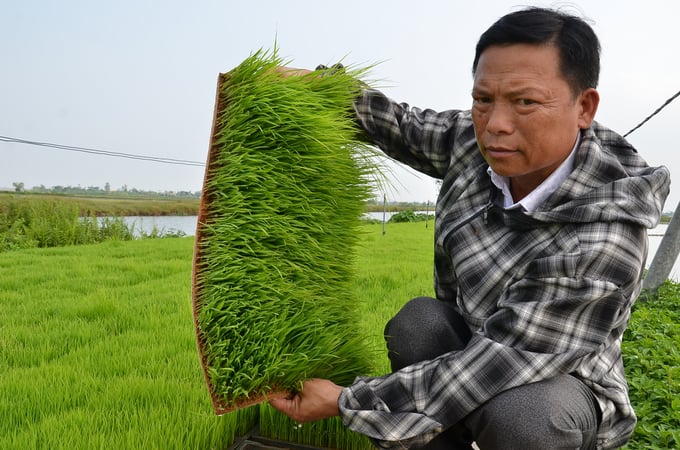June 21, 2025 | 02:18 GMT +7
June 21, 2025 | 02:18 GMT +7
Hotline: 0913.378.918
June 21, 2025 | 02:18 GMT +7
Hotline: 0913.378.918
"Thai Binh currently has 1,700 ‘big farmer’ households planting 2 ha of field or above. There are 140 households planting 5 ha of field, and 120 households planting 7 ha or above. Once ‘big farmers’ make their appearance, a definite campaign to form new-style cooperatives can help them enjoy all the regimes and policies of the state. They would no longer have to ‘swim by themselves’ anymore", said Dinh Vinh Thuy, Director of Thai Binh Department of Agriculture and Rural Development.
What is the policy of Thai Binh province towards “big farmers”, sir?
The rural economic structure has changed sharply in the direction of rapidly increasing the proportion of industry and services while rapidly decreasing the proportion of agriculture. Thai Binh is known as an agricultural province. Agriculture once accounted for 40-45% of the economic proportion, but now it is only about 21%.
Such economic transition leads to a shift of labor, causing a serious shortage of human resources in agriculture. The land use coefficient decreased from 2.5-2.8 times to approximately 2 times at present, not to mention there are many abandoned fields. Thai Binh has issued a policy to support the exchange and accumulation of land in two directions: The first is to support the local public in directing and mobilizing farmers to rent fields to others, with a fee of VND 1 million/year for 1 ha. The second is to support the lessor 10 kg of rice per year. That policy is implemented in 2022 while following the criteria that the rental area must be 10 ha or more.

Tran Xuan Luong from Quang Hung commune, Kien Xuong district is a pioneer in the “big farmer” movement. Photo: Duong Dinh Tuong.
After having such a policy, the rate of land accumulation has shown clear signs of increase. The proof is that by the end of 2021, only 968 “big farmer” households, now there are 1,700 “big farmer” households farming on fields of 2 ha or above. Through the survey, the profit is visible. There are people who even profit up to VND 1.4 billion/year.
I heard that the concept ”farmer on high heels” was yours when mentioning farmers like Tran Thi Lanh who planted 100 ha of rice. So can you explain more about this?
I think that modern farmers are farmers with neckties and white shirts, standing up to direct, hiring others to do the job, not like in the old days when they always have to carry hoe, plow, and work days and nights in the field. And Ms. Tran Thi Lanh is a prime example of that image. She buys machinery, hires others to do the work. She wears high heels, participates in forums, and promotes her rice products.
The future is in sight, but from the reality of 1,700 “big farmer” households in Thai Binh, the path ahead remains full of difficulties.
The first thing to consider is that when the production scale is expanded, there would more machines and more rice harvested. There must be a place for processing, storage and management. How can one farming household have land to do all that?
The second thing is that we often use the word “big farmers”, but in the end they are still farmers. They lack the knowledge to organize production to gain clear product origin, ensure safety, and perform marketing well.
The third thing is that the market still poses a heavy impact on farmers. If they do things alone, they would have to buy inputs at a high price, unable to cooperate and use the machines of a separate household to support each other. This would result in low production efficiency.
From that fact, I organized a meeting with “big farmer” households, telling them that in the first stage, the farmers had a field, so for the next stage it was more important to organize production. It is definitely a must to form the new type of cooperative because only by linking together can we do things that the household economy cannot solve.
Enterprises have come to associate with Thai Binh’s agriculture industry, reaching a rate of over 10% of the area. The problem is that the cooperation lacks solidity. The situation of “this crop works, the next crop ends” happens because many farmers would look for businesses when they can't sell their goods, but if they can do it by themselves, they will break the contract. Associating with the new type of cooperative with a large field like the “big farmers” will help businesses ensure that farmers will never break the contract.

“There should be a support mechanism for people to accumulate land,” said Dinh Vinh Thuy, Director of Thai Binh Department of Agriculture and Rural Development. Photo: Duong Dinh Tuong.
I have this feeling that the “big farmers” are mainly "swimming by themselves", but the state has not yet had specific policies for this. What is your opinion about this matter?
There are two things that the government needs to do. The first is to make a census of the entire number of farming households in the area, thereby determining who wants to farm and who doesn't.
Those who have the desire to farm will be compactly planned into one area, and those who do not will also be planned into an area according to each village, each commune. Thai Binh Department of Agriculture and Rural Development has advised the province to do so in the sectoral structure scheme but has not been able to implement it.
The next thing is to promulgate a mechanism to support people to accumulate and concentrate land (this already exists), the lessor, the cadres in the commune, and the tenants will benefit from the "field bank" in their locality, following the direction of long-term rental. That is phase 1.
In phase 2, when “big farmers” appear, we must mobilize them to form new cooperatives and through that they will enjoy all the regimes and policies of the state, no longer having to "swim by themselves". Both phases must be performed in parallel.
Out of 120 representative households with an area of 7 hectares or more, from the beginning of the year to now, 2 have died due to accidents. So what is your opinion about labor safety when moving to large-scale production?
Farmers in our country have almost no training, and their awareness is still limited. In the past, there were tens of thousands of farmers in Thai Binh, the program was likely to be difficult, but now that the number is condensed to 1,700 “big farmer” households, we are ready to train and provide them with knowledge like how to operate machinery and equipment or how to take precaution when farming. That way the accidents and risks will surely be reduced.

Tran Xuan Luong the “big farmer” working in the field. Photo: Duong Dinh Tuong.
From the “big farmer” reality of Thai Binh, what in your opinion is deemed essential if you want to do it on a national scale?
I think the state should provide a certain amount of financial support so that localities can apply this concept well. They must direct and review the number of households, then propagate and mobilize those who are passionate to gather the fields in one place, arrange the best field for them, and those who do not work can go to another area.
There should be a support mechanism for people to gather and change the area. Thai Binh only has public assistance in directing and supporting those who have rented fields. Those who rent fields currently have none of that. In fact, they already have, but in an indirect way, because the lessors will lower the rental price if they are supported with 10 kg of rice/360 m2/year.
Central Resolution 5 stated that localities should form a “field bank", and leasing from that is the most sustainable way and we must accelerate the process. Regarding the amendment of the Land Law, the low land limit also restricts the accumulation to some extent.
The “big farmer” movement is still spontaneous in the localities, but if there is a unified policy from the central to the local level like Resolution 10, making it a key political task of the Party committees and authorities at all levels, only then will it succeed. Our farmers are still heavy on private land ownership! The field is not transplanted, but farmers would definitely not want to let it go or lease it to others.
Thank you, sir!
Translated by Samuel Pham
![Turning wind and rain into action: [9] Digitizing hydrometeorological data in response to climate change](https://t.ex-cdn.com/nongnghiepmoitruong.vn/608w/files/news/2025/06/17/z6704423696987_15fd32ffc26d590d204d520c9dac6786-nongnghiep-165943.jpg)
(VAN) Farmers have begun accessing hydrometeorological applications to adjust their cropping schedules, aiming to ensure productivity and adapt to climate change.
![Turning wind and rain into action: [8] Real-time salinity detection and early warning technology](https://t.ex-cdn.com/nongnghiepmoitruong.vn/608w/files/news/2025/06/17/z6704423696987_15fd32ffc26d590d204d520c9dac6786-nongnghiep-151127.jpg)
(VAN) Thanks to the integration of modern hydrological-hydraulic models, remote sensing technologies, and artificial intelligence, the accuracy of hydrological forecasting has significantly improved.
![Turning wind and rain into action: [7] Early disaster warnings help marine farmers minimize losses](https://t.ex-cdn.com/nongnghiepmoitruong.vn/608w/files/news/2025/06/17/z6704423696987_15fd32ffc26d590d204d520c9dac6786-nongnghiep-142942.jpg)
(VAN) In recent years, thanks to early disaster warnings and forecasting, marine farmers in Khanh Hoa province have been able to reduce risks and losses, thereby improving production efficiency.
![Turning wind and rain into action: [6] ‘Four on-the-spot’ disaster management software](https://t.ex-cdn.com/nongnghiepmoitruong.vn/608w/files/news/2025/06/17/e5a48259d6a262fc3bb3-nongnghiep-183800.jpg)
(VAN) By simply activating the scenario on the disaster management software, the relevant authorities immediately know how many households need to be evacuated, where to evacuate them to, and by what means of transportation…
![Turning wind and rain into action: [5] Hue applies modern technology in disaster forecasting](https://t.ex-cdn.com/nongnghiepmoitruong.vn/608w/files/news/2025/06/17/z6704423696987_15fd32ffc26d590d204d520c9dac6786-nongnghiep-093938.jpg)
(VAN) In Hue city, modern technology has recently been applied in meteorological and hydrological forecasting and warning, helping to reduce the damage caused by natural disasters.

(VAN) A cutting-edge farming technique being implemented on an experimental ranch in Arizona's Sonoran Desert has already saved a billion gallons of water over five years, according to Civil Eats.

(VAN) Poultry and pig production and the environment can be boosted through enhanced water technology, according to new research.